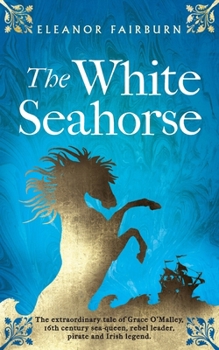The White Seahorse
Connacht, Ireland, 1537 Graunya O Malley ... Born of the sea. From the rugged west coast of Ireland to the power-crazed court of Elizabeth I, Graunya O Malley sails her fleet and commands her men - with fierce determination. The White Seahorse charts not only the life of the legendary 'Graunuaile' - queen to some, pirate to others - but the fate of the Irish tribes that she tried to protect against the growing might of the English Empire under Elizabeth Tudor. Two powerful women, as yet unaware of each other's existence, shared a unique conviction: that in an age of Reformation, war and politics, a woman can be both strong and vulnerable, but it is dangerous to love...
Format:Paperback
Language:English
ISBN:B09L33918F
ISBN13:9798759647263
Release Date:November 2021
Publisher:Independently Published
Length:386 Pages
Weight:0.84 lbs.
Dimensions:0.8" x 5.0" x 8.0"
Related Subjects
Contemporary Ethnic & National Fiction Genre Fiction Historical Irish Literature & FictionCustomer Reviews
1 rating
The White Seahorse
Published by Thriftbooks.com User , 20 years ago
Granuaile, a.k.a. Grace O'Malley, was a pirate queen who lived during the Elizabethan age. And if this is news to you, then that is not surprising. Written Irish history appears to have overlooked what must have been one of the country's most colourful characters. So, for once, we have the annals of England history to thank for preserving her story, as Elizabethan scribes kept full detail's of her adventures which were frequently mentioned in letters of the day. In The White Seahorse, Eleanor Fairburn expertly reconstructs Granuaile's life from the various records, presenting it in the form of a historical novel which opens during her childhood in 1537. Graunya is seven years old and already pines for a life at sea with her father, the O'Malley clan chieftain. She crops off her long hair off to prove her determination and her father grants Granuaile a place on his trading ship. The novel follows Granuaile through her first marriage, the birth of four children and the growth of her own merchant fleet until the death of her husband, Dhonal Nacugga, in a disasterous raid; her establishment of a naval base on Clare Island, long an O'Malley holding, and her defiance of an English ban on Irish trade; a second marriage, her separation, her growing troubles as Ireland's rebellion grows, and ultimately her direct confrontation with Queen Elizabeth. If all the above sound like the ingredients of a blockbuster swashbuckler of a tale, then you would not be wrong. This is encapsulated in one scene where Granuaile has been imprisoned in a dungeon in Galway City for attacking a merchant ship and is facing the death penalty. She is then taken to the house of Sir Edward Fitton, where a party is underway. The Lord President has her informed (for Granuaile speaks no English) that he wishes her to dance for the amusement of the guests. She agrees to dance the male part of a Galician jota if the smallest woman in the room partners her, and honour that falls upon Jane Smyth, the daughter of the Chief Apothecary of Dublin Castle. The couple dance and Granuaile gradually maneuvers them both towards the nearest pane glass window. Suddenly, she picks Jane up, hurls her smashing through the window, jumps through after her, rolls down the grass, is over the wall onto a waiting horse and is away. How on earth have Hollywood missed out on this? Of course it is difficult to judge how much of Fairburn's novel is factual and how much is added colour. But I have been assured that the broad strokes of Granuaile's life as portrayed in the novel are historically correct. To give the story more grounding, Fairburn parallels Granuaile's life with events of political intrigue in England: from Henry VIII's reign through Lady Jane Grey's nine days of power, Bloody Mary's violent oppression and Elizabeth Tudor's rise to power. In fact, in comparing Granuaile and Elizabeth Tudor, Fairburn highlights the similarities of two very different women of power in what was still a man






